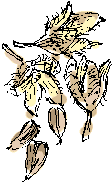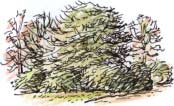BeechcomberSunday, 20th October 2002, West Yorkshire |
![]()
![]()
![]()
![]() Rocks |
History | Workshop |
Links | Home
Page
Rocks |
History | Workshop |
Links | Home
Page
![]()
 'Look out!'
'Look out!'As my mum turns into the drive I spot a huddled shape ahead of us. It soon resolves itself into a grey squirrel and hops up, tail undulating gracefully into next door's shrubbery.
'Yes!' exclaims my mum, 'and it's been very active digging in my flowerbeds.'
 It's the beech nuts, scattered over the driveway, that seem to be the attraction at the moment. The conker season has all but drawn to an end.
It's the beech nuts, scattered over the driveway, that seem to be the attraction at the moment. The conker season has all but drawn to an end.I remember as a young child that the big beech tree had a lot of variegated leaves on some of it boughs. They were green with white edging, if I remember rightly. Gradually the all-green boughs have grown at the expense of the all-variegated. Having that much more chlorophyll the all-green leaves are more vigorous in growth.
Tree of Life
 This
raises some questions about the genetic code of the beech tree. I assume
there's a sequence in the DNA in parts of this tree that leads to variegated
leaves. In adjacent boughs whatever gene produces that variegation is 'switched
off', or whatever the term is for it.
This
raises some questions about the genetic code of the beech tree. I assume
there's a sequence in the DNA in parts of this tree that leads to variegated
leaves. In adjacent boughs whatever gene produces that variegation is 'switched
off', or whatever the term is for it. It's like the perennial discussion about babies; 'He's got his mother's nose!', 'But those are his Auntie Doris's ears!', 'Well, those are definitely his dad's feet!'
It's like the perennial discussion about babies; 'He's got his mother's nose!', 'But those are his Auntie Doris's ears!', 'Well, those are definitely his dad's feet!'It's as if the tree had an assortment of genetic variations in its various branches. I've mentioned variegation which is easy to spot but there might be biochemical variations that are not so easy to observe and which we're unaware of. This isn't so very unlikely. The problems of rejection of a transplanted limb isn't as serious a problem in a tree as it is in a human. A family apple tree, as they're called, can have three different varieties - a cooker, an eater, a keeper - grafted onto a rootstock which is itself a different variety.
 But even without grafting it seems possible that a tree, or some trees at
least, can have a natural variation in genetic makeup from branch to branch.
But even without grafting it seems possible that a tree, or some trees at
least, can have a natural variation in genetic makeup from branch to branch.
How this would come about I'm not sure. 'Random' variation? Damage to the budding limbs by ultra-violet light?
Whatever the reason for the variation I could see that it might be of value to the tree. If the tree was attacked by disease or by parasites there would be a chance that some of the boughs would prove more resistant to the attack. If there was a change in climate some branches might
There's always a side of a tree that gets full sun and another that gets full shade; again if genetic variation could kick in there might be an advantage here; but I can't imagine any mechanism that would produce the right result for the right branch.
Perhaps, if there was such a process, it would be a case of trial and error.
![]()
Richard Bell,
wildlife illustrator
E-mail; 'richard@willowisland.co.uk'
![]() Next
page | Previous
page | This
day last year | This month |
Nature Diary |
Home
Page
Next
page | Previous
page | This
day last year | This month |
Nature Diary |
Home
Page
![]()